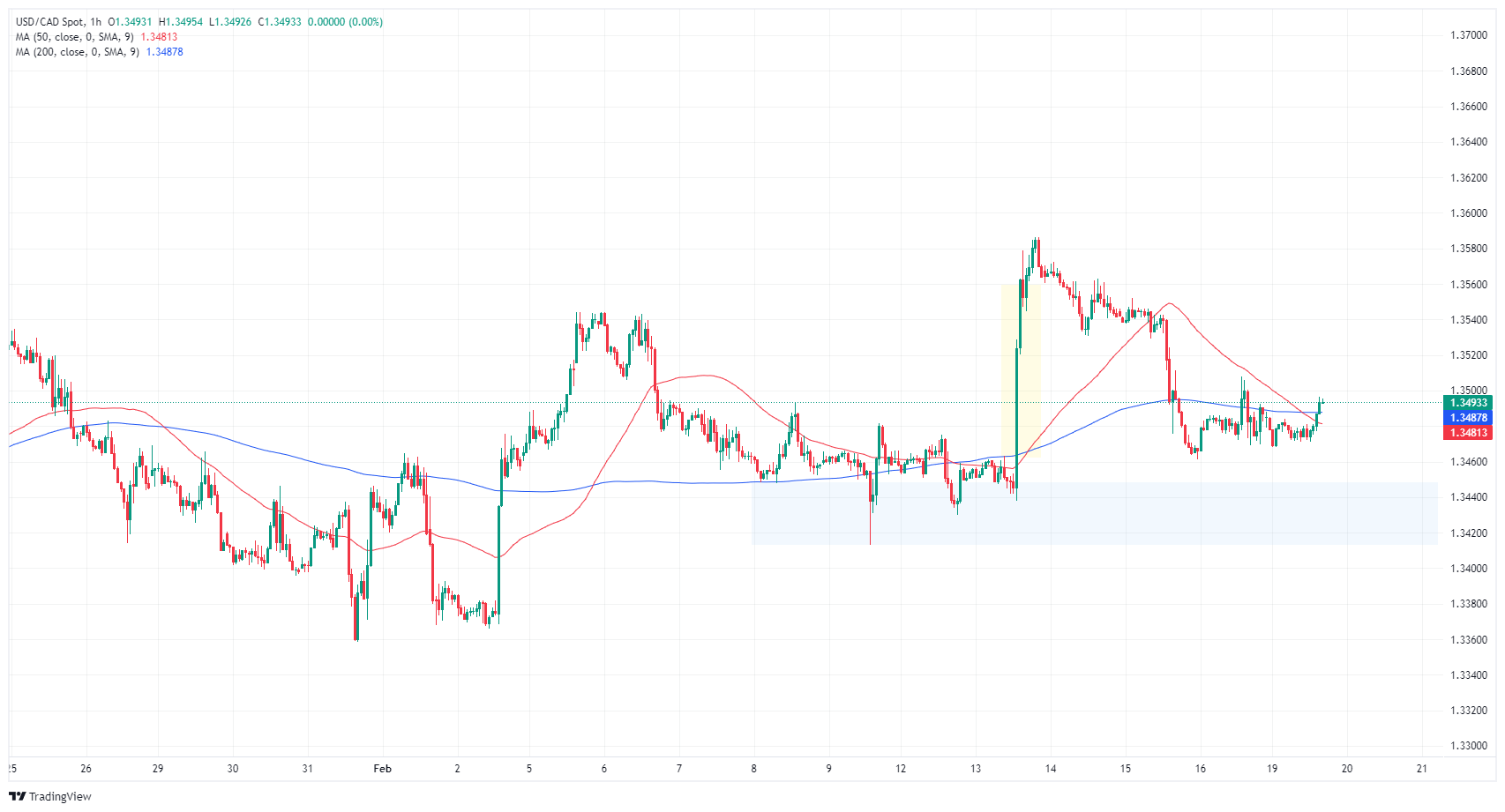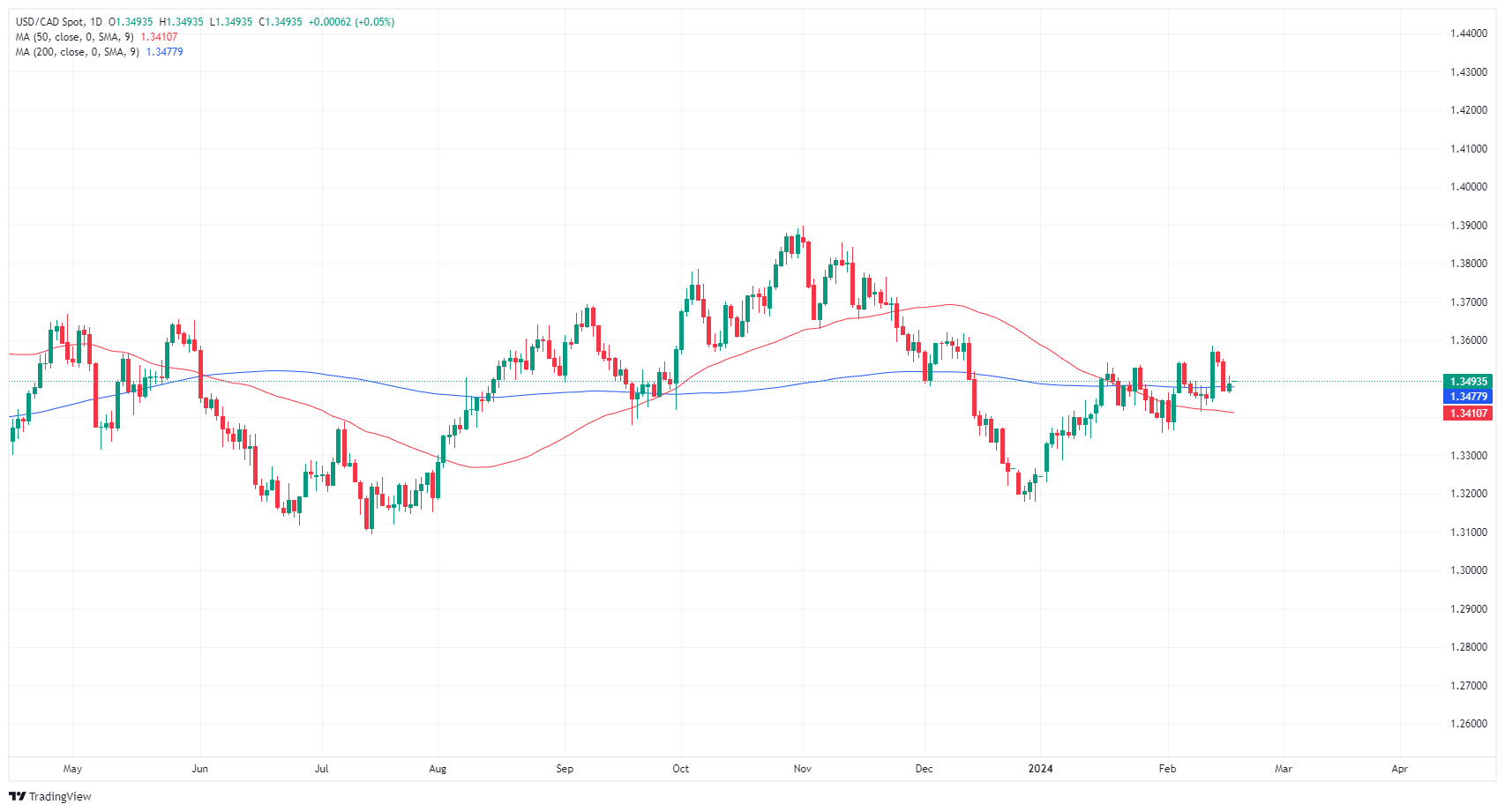Canadian Dollar flat with US markets out for holiday Monday, Canadian CPI inflation around the corner

- Thin Monday market churn as traders wait for big data prints this week.
- Canada, US both have bank holidays on Monday, throttling trading volumes.
- Tuesday brings Canadian CPI inflation, US FOMC Meeting Minutes on Wednesday.
The Canadian Dollar (CAD) is stuck in a near-term technical range as the new trading week kicks off with a thin market profile. Canadian and US financial institutions are dark on Monday, with two-thirds of Canadians taking the day off. Canada’s financial sector, specifically the Toronto Stock Exchange, is closed for the day. The US is also observing Presidents’ Day, and American institutions will start the new trading week on Tuesday.
Canada brings another Consumer Price Index (CPI) inflation print on Tuesday, and broader markets will be keeping a close eye on Wednesday’s Federal Open Market Committee (FOMC) Meeting Minutes as investors look out for how close the US Federal Reserve (Fed) is to cutting interest rates.
Daily digest market movers: Canadian Dollar churns in flat-sided markets
- The Canadian Raw Material Price Index rose 1.2% in January versus December’s -4.9%.
- Canadian MoM Industrial Product Prices shrank a scant -0.1% in January compared to December’s -1.6% (revised slightly from -1.5%).
- Both metrics are decidedly low-impact, barely moved the needle despite Raw Materials posting a fourth straight month in contraction territory.
- Tuesday’s YoY Canadian CPI inflation is expected to tick down slightly to 3.3% from the previous period’s 3.4%.
- MoM Canadian CPI inflation is expected to rebound to 0.4% in January from December’s -0.3%.
- Canada CPI Preview: Inflation likely eased in January.
- Canadian Retail Sales slated for Thursday are expected to show a MoM rebound to 0.8% in December compared to November’s -0.2%.
- Wednesday’s FOMC Meeting Minutes will pull the veil back on the Fed’s internal discussions about the US central bank’s interest rate stance.
- According to the CME’s FedWatch Tool, money markets are expecting a first rate trim from the Fed in June, with over 90% odds of another rate cut in July.
Canadian Dollar price today
The table below shows the percentage change of Canadian Dollar (CAD) against listed major currencies today. Canadian Dollar was the weakest against the New Zealand Dollar.
| USD | EUR | GBP | CAD | AUD | JPY | NZD | CHF | |
| USD | 0.16% | 0.18% | 0.10% | 0.04% | 0.05% | -0.12% | 0.12% | |
| EUR | -0.16% | 0.02% | -0.06% | -0.12% | -0.11% | -0.28% | -0.04% | |
| GBP | -0.18% | -0.01% | -0.08% | -0.14% | -0.12% | -0.29% | -0.05% | |
| CAD | -0.10% | 0.06% | 0.06% | -0.06% | -0.05% | -0.22% | 0.02% | |
| AUD | -0.02% | 0.14% | 0.13% | 0.08% | 0.03% | -0.14% | 0.10% | |
| JPY | -0.05% | 0.11% | 0.15% | 0.05% | -0.01% | -0.16% | 0.08% | |
| NZD | 0.12% | 0.28% | 0.29% | 0.22% | 0.16% | 0.17% | 0.25% | |
| CHF | -0.13% | 0.04% | 0.05% | -0.03% | -0.08% | -0.08% | -0.25% |
The heat map shows percentage changes of major currencies against each other. The base currency is picked from the left column, while the quote currency is picked from the top row. For example, if you pick the Euro from the left column and move along the horizontal line to the Japanese Yen, the percentage change displayed in the box will represent EUR (base)/JPY (quote).
Technical analysis: Canadian Dollar mixed on quiet Monday
The Canadian Dollar (CAD) spreads on Monday, mixed against the major currency basket at the start of the new trading week. The CAD is up a scant tenth of a percent against the Euro (EUR) and the Pound Sterling (GBP) but down a fifth of a percent against the broadly-recovering New Zealand Dollar (NZD) on Monday.
The USD/CAD is cycling within near-term technical boundaries near 1.3500, and the pair remains just north of a supply zone between 1.3440 and 1.3420. The pair spent most of the last week closing last Tuesday’s Fair Value Gap (FVG), and traders will be looking for a break of structure to bring the USD/CAD back into buying territory below 1.3460.
USD/CAD remains hampered by the 200-day Simple Moving Average (SMA) at 1.3478, and near-term price action is finding thin but steady technical support from the 50-day SMA near 1.3410.
USD/CAD hourly chart
USD/CAD daily chart
Inflation FAQs
Inflation measures the rise in the price of a representative basket of goods and services. Headline inflation is usually expressed as a percentage change on a month-on-month (MoM) and year-on-year (YoY) basis. Core inflation excludes more volatile elements such as food and fuel which can fluctuate because of geopolitical and seasonal factors. Core inflation is the figure economists focus on and is the level targeted by central banks, which are mandated to keep inflation at a manageable level, usually around 2%.
The Consumer Price Index (CPI) measures the change in prices of a basket of goods and services over a period of time. It is usually expressed as a percentage change on a month-on-month (MoM) and year-on-year (YoY) basis. Core CPI is the figure targeted by central banks as it excludes volatile food and fuel inputs. When Core CPI rises above 2% it usually results in higher interest rates and vice versa when it falls below 2%. Since higher interest rates are positive for a currency, higher inflation usually results in a stronger currency. The opposite is true when inflation falls.
Although it may seem counter-intuitive, high inflation in a country pushes up the value of its currency and vice versa for lower inflation. This is because the central bank will normally raise interest rates to combat the higher inflation, which attract more global capital inflows from investors looking for a lucrative place to park their money.
Formerly, Gold was the asset investors turned to in times of high inflation because it preserved its value, and whilst investors will often still buy Gold for its safe-haven properties in times of extreme market turmoil, this is not the case most of the time. This is because when inflation is high, central banks will put up interest rates to combat it.
Higher interest rates are negative for Gold because they increase the opportunity-cost of holding Gold vis-a-vis an interest-bearing asset or placing the money in a cash deposit account. On the flipside, lower inflation tends to be positive for Gold as it brings interest rates down, making the bright metal a more viable investment alternative.
